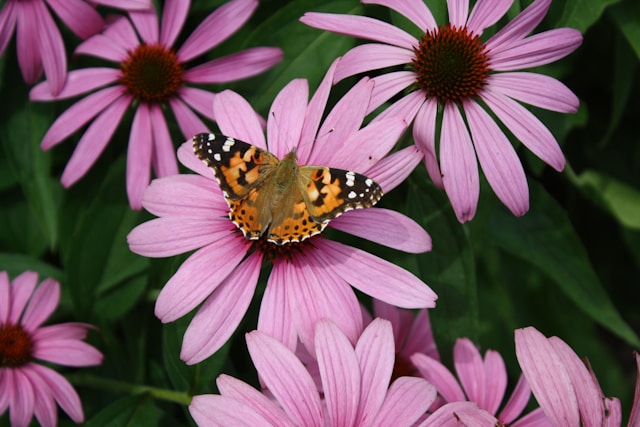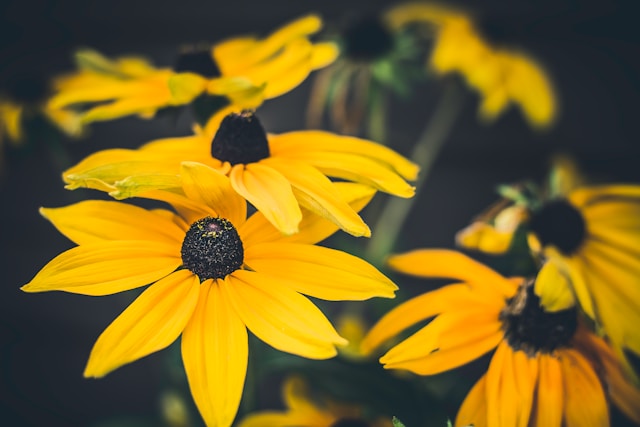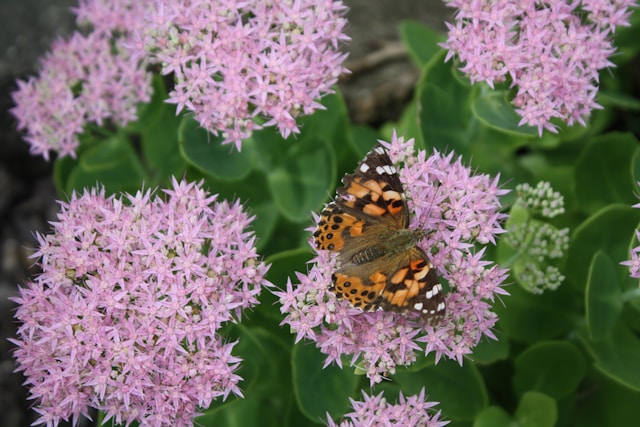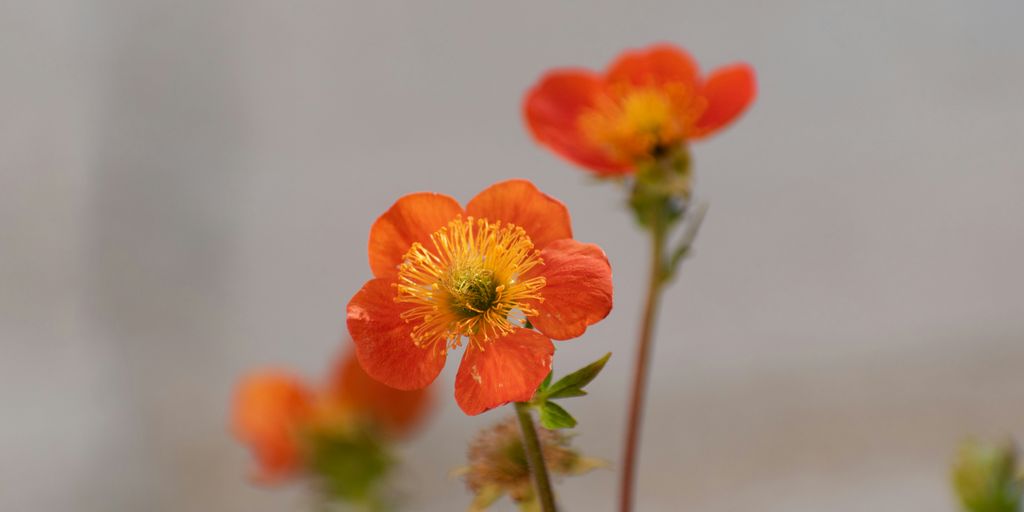Perennial flowers are a great choice for gardeners looking to add long-lasting color and beauty with minimal effort. These hardy plants come back year after year, requiring little maintenance once established. Some top low-maintenance perennial flower options include:
1. Coneflower

Coneflower is a mid-summer bloomer that’s a great cut flower. There are many different varieties in many colors. Coneflower is deer resistant and attracts butterflies. Plant in full sun.
Requiring little fuss, coneflowers (Echinacea) are a busy gardener’s dream. This perennial plant’s most prominent feature is the large, showy composite flowers. Each flower consists of a raised cone-shaped center which is surrounded by colorful ray florets. The ray florets radiate outward from the cone and can be various shades of pink, purple, white, or even yellow, depending on the cultivar.
Hot, sunny weather won’t stop coneflower from producing armloads of flowers from early summer until fall. This low-maintenance perennial flower is a native plant that’s easy to grow and comes in purple, white, yellow, orange, and red. Most varieties have single flowers, but some newer hybrids sport eye-popping double blooms. The nectar-rich flowers will also attract butterflies and hummingbirds to your garden.
- Zones: 3 to 9
- Size: 2 to 4 feet tall x 1 to 2 feet wide
- Care requirements: full sun (drought-tolerant once established); well-drained soil
Coneflowers are a fantastic choice for gardeners looking to add vibrant colors and attract pollinators without much effort.
2. Shasta Daisy

Shasta Daisies are a classic favorite in cottage-style borders, revered for their cheery flowers with snowy white petals and yellow centers. This hardy herbaceous perennial is tolerant of drought and different soils, and is resistant to diseases, insect pests, deer, and rabbits. Full sun and good drainage are essential for optimal growth.
Growing Conditions
- Zones: 5-9
- Exposure: Full sun to part shade
- Height/Spread: 6 to 48 inches tall, 13 to 36 inches wide
- Bloom time: Early summer to fall
Planting Tips
- Choose well-drained soil.
- Select different varieties for different heights: short ones for borders and tall ones for a dramatic backdrop.
- Ideal for mixed borders or cottage-style landscapes.
Maintenance
- Low maintenance and great as cut flowers.
- Regular deadheading can promote more blooms.
Shasta Daisies are perfect for gardeners looking for a low-maintenance yet visually appealing addition to their garden.
3. Black-Eyed Susan

Effortlessly radiant and endlessly charming, the black-eyed Susan (Rudbeckia hirta) features golden petals and striking dark centers, adding a burst of sunshine to any landscape. Black-eyed Susan flowers are prolific bloomers and can create a stunning display of color in the garden, typically from mid-summer to early fall. What truly sets this perennial plant apart is its remarkable ability to thrive with minimal care.
Growing Conditions
- Zones: 3-9
- Exposure: Full sun
- Habit: Upright habit
- Height/Spread: 1 to 4 feet tall, 1 to 2 feet wide
- Bloom time: Summer to fall
Maintenance
Black-eyed Susan is tolerant of poor soil, has few pests or diseases, and needs little or no maintenance except for deadheading. Naturalize this North American native in meadows, borders, or mass plantings.
Varieties
- ‘Goldsturm’: A common variety known for its reliability and vibrant color.
- ‘Early Bird Gold’: A selection that starts blooming early and continues throughout the season.
Black-eyed Susans are a favorite flowering perennial for cottage-style gardens. Their daisy-like rays of petals occur in rich tones of gold, bronze, and brown, making them a versatile choice for various garden designs.
4. Astilbe

Astilbe is a versatile perennial that thrives in moist, semi-shaded areas such as woodland borders and along stream banks. This plant is known for its delicate ferny foliage and feathery flower spikes that come in a variety of colors including red, purple, lavender, pink, and white. Astilbe is exceptionally hardy, tolerant of different light conditions, and resistant to pests and diseases.
Growing Conditions
Astilbe prefers part shade to full shade and moist, well-drained soil. While traditionally a shade plant, newer astilbe hybrids can tolerate more sun.
Varieties
Astilbe comes in several varieties, with the most common being hybrids like Astilbe x arendsii. These hybrids are derived from various crosses of species such as A. chinensis, A. japonica, A. thunbergii, and A. astilboides.
Maintenance
Astilbe requires little to no maintenance, making it an excellent choice for low-maintenance gardens. It is important to keep the soil consistently moist, especially during dry periods.
Astilbe’s ability to thrive in different light conditions and its resistance to pests and diseases make it a reliable choice for any garden.
Companion Plants
Astilbe pairs well with other shade-loving plants like azalea, camellia, and rhododendron. Avoid planting it near cacti, lavender, and rosemary as these plants have different moisture and light requirements.
5. Frikart’s Aster
Frikart’s Aster is a perennial plant that is easy to care for, disease-resistant, and boasts a long bloom time. Its light purple blooms flower nonstop from July to the first frost. This makes it one of the best choices for gardeners looking for low-maintenance yet vibrant additions to their gardens.
Growing Conditions
- Full sun
- Well-drained soil
- Appreciates water during droughty periods
Size
- Up to 3 feet tall and wide
Zones
- 3-9
Benefits
- No staking required
- Supports late-season pollinators like bees and butterflies
- Ideal for meadows or native landscapes
Frikart’s Aster is one of the best Karl Foerster grass companion plants, offering aesthetic harmony and shared growing conditions.
6. Daylily
Daylilies (Hemerocallis spp. and hybrids) are staples in a perennial garden, with literally thousands of varieties available. Despite the name, these are not lilies at all, but belong to a different genus that includes about 15 common species. For garden use, it is not the species that are usually planted, but rather hybrid cultivars that have been developed over the last 150 years.
One of the remarkable qualities of daylilies is their ability to withstand different light conditions. They perform best in full sun to partial shade, allowing you flexibility in their placement within your garden. The star attraction of daylilies is their flowers: each flower typically lasts for a single day, hence the name daylily.
This upright, fragrant flower comes in a variety of colors, including light to bright-pink petals and a yellow throat. They grow in dense clumps and require full sun or partial shade. They bloom all summer and contrast beautifully against their dark green foliage.
One of the most popular summer flowering perennials, daylily is grown for the strappy green foliage and trumpet-shaped flowers that come in a wide range of colors and patterns. Plants are exceptionally hardy, long-lived, and virtually carefree once established. Provide regular water and well-draining soil. Use in a mixed border, beds, and mass plantings.
7. Sedum

Sedum is a diverse group of succulents with fleshy leaves, clusters of star-shaped flowers, and an upright, mounding, or ground cover habit. This tough perennial prefers full sun and lean, dry soil with good drainage. Plants are drought tolerant and deer resistant, and need little or no supplemental fertilizer or water once established. Use in rock gardens and waterwise landscapes.
Growing Conditions
- Sun Exposure: Full sun
- Soil Needs: Dry to medium moisture, well-drained soil
- Size: Up to 3 feet tall and wide
- Zones: 4-8
Varieties
Sedums come in many varieties, from creeping groundcovers to upright shrub-like plants. The flowering period varies by species; some are spring bloomers while others flower in late summer and fall.
Maintenance
These plants are incredibly low maintenance. They will thrive in almost any conditions, except for very soggy soils, which can cause root rot.
Sedum gives you a sense of just how maintenance-free these plants can be. The many varieties of sedum can look very different, but they are all perennial plants with fleshy leaves that store moisture.
8. Russian Sage

Description
Russian sage (Perovskia atriplicifolia) is a resilient plant that requires minimal care while delivering maximum impact. One of the standout features of Russian sage is its profusion of small, tubular flowers that form dense spikes or panicles. The flower spikes rise above the foliage, creating an impressive and airy display. The blooming period generally occurs in mid- to late-summer and can last well into fall, attracting pollinators like bees and butterflies.
Growing Conditions
- Sunlight: Full sun
- Soil: Dry to medium moist, well-drained soil
- Zones: 4-8
- Size: Up to 2 feet tall and wide
Maintenance
This undemanding woody perennial prefers leaner soil and needs little or no supplemental fertilizer. Plants are heat and drought tolerant, as well as deer resistant. In some regions, this mint-relative can grow too well, spreading itself aggressively by seeds and underground stems, so plant where you can keep it contained.
Companion Plants
Russian sage is the perfect partner for coneflower and black-eyed Susan. It also pairs well with other perennials like lavender and sedum. However, avoid planting it near more aggressive plants like mint or bamboo.
Russian sage produces silvery green foliage and long-lasting lavender-blue flower spikes from late summer into fall. This easy-to-grow plant is a great addition to any garden looking for a low-maintenance yet visually appealing option.
9. Catmint

Catmint (Nepeta spp.) is a fast-growing perennial that features graceful stalks of blue, white, or pink flowers in the spring. It will quickly rebloom if you cut the plants back after the first flush of flowers fades. Catmint also has fragrant foliage that you can dry. For best effect, plant this rugged bloomer in large drifts or clumps.
Growing Conditions
- Zones: 3-9
- Exposure: Full sun to part shade
- Height/Spread: 1 to 3 feet tall and wide
- Bloom time: Late spring to fall
Maintenance Tips
- Cut back after the first flush of flowers fades to encourage reblooming.
- Requires little supplemental fertilizer or watering.
- Tolerant of most soils.
Benefits
- Attracts bees, butterflies, and hummingbirds.
- Exceptionally cold hardy.
- Adds beauty to herb gardens, mixed borders, or rockeries.
Nepeta is one of the best low maintenance perennials, with soft gray-green foliage and blue, lavender, or white tubular flowers that bloom for months.
10. Yarrow

Yarrow (Achillea spp.) is a versatile and low-maintenance perennial that thrives in various conditions. It grows between one to four feet tall and two to three feet wide, making it a great addition to any garden.
Characteristics
Yarrow features delicate, fern-like foliage and flat-topped clusters of flowers that come in a variety of colors, including white, yellow, pink, and red. These flowers are especially attractive to pollinators like hummingbirds, bees, and butterflies.
Growing Conditions
- Zones: 3 to 11
- Exposure: Full sun
- Soil: Sandy, acidic, well-drained soil
Care Requirements
Yarrow is drought-tolerant and can thrive even in dry summers. However, it does have a tendency to flop in windy conditions or when planted in shady areas. To maintain its shape and encourage new growth, you may need to divide the plant every few years.
Even in times of drought, you can count on yarrow to thrive in your garden. Its aromatic, ferny foliage supports a midsummer explosion of gorgeous flowers.
Benefits
- Attracts pollinators: Hummingbirds, bees, and butterflies
- Resistant to: Insect pests, diseases, and deer
- Ideal for: Meadow gardens or wildlife-friendly landscapes
Conclusion
Choosing the right low-maintenance perennial flowers can transform your garden into a vibrant, ever-blooming oasis with minimal effort. These hardy plants not only save you time and money but also bring a variety of colors, textures, and heights to your outdoor space. Whether you’re a beginner or an experienced gardener, the perennials listed in this article are sure to thrive year after year, requiring little to no attention once established. By incorporating these easy-to-grow flowers into your garden, you can enjoy a beautiful, low-maintenance landscape that flourishes in different hardiness zones. Happy gardening!
Zaki Infitar is the driving force and creative mind behind GreenBuilt.co. As a self-taught gardener with an unwavering passion for all things green, Zaki’s journey into the world of gardening is a testament to his dedication and love for nature.

